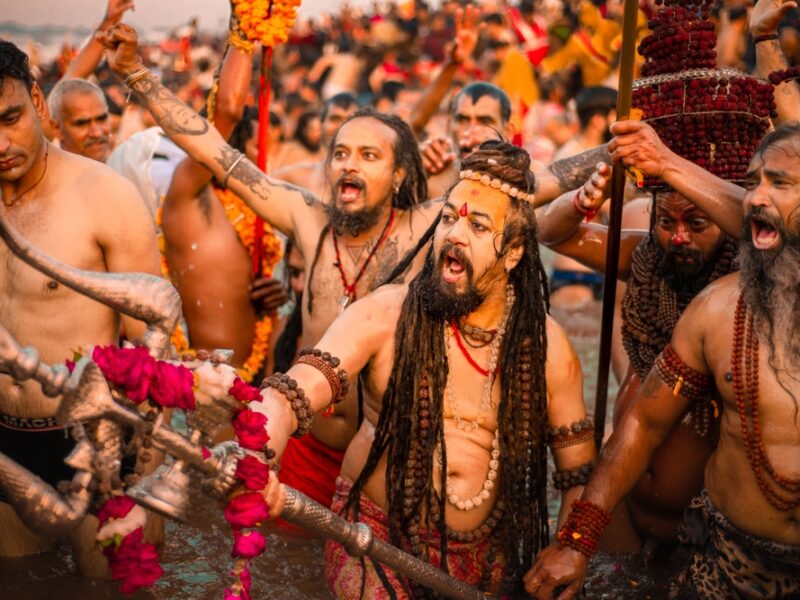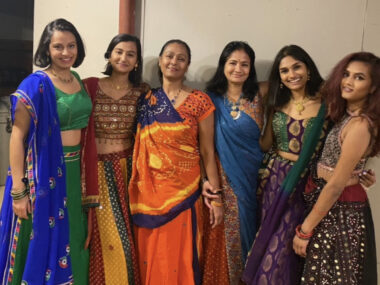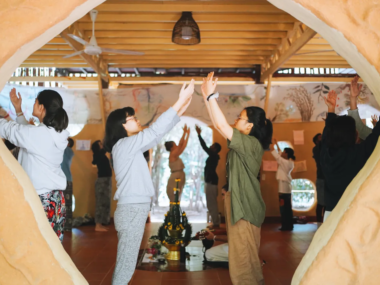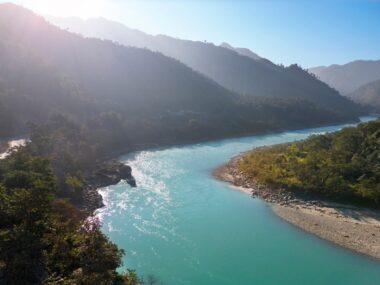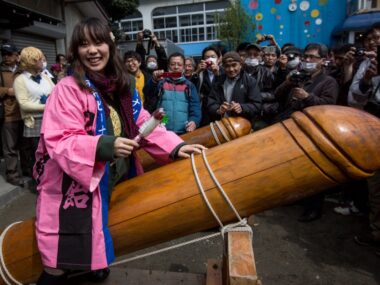Table of Contents
My sin list kept growing as the Mahakumbh Special Train finally limped onto Platform 4 at Prayagraj Junction, five hours late and packed with enough humans to fill Liechtenstein twice over.
I was wedged between a middle-aged lady clutching a steel tiffin like it held the last horcrux and an elderly man whose elbow had basically entered a long-term relationship with my ribcage for the past thirteen hours.
My feet were numb, my scalp itched, and my mom kept shooting me “I told you this would suck” looks.
Yet my heart was back-flipping: I was about to witness divinity unfold in its most majestic form at Mahakumbh 2025.
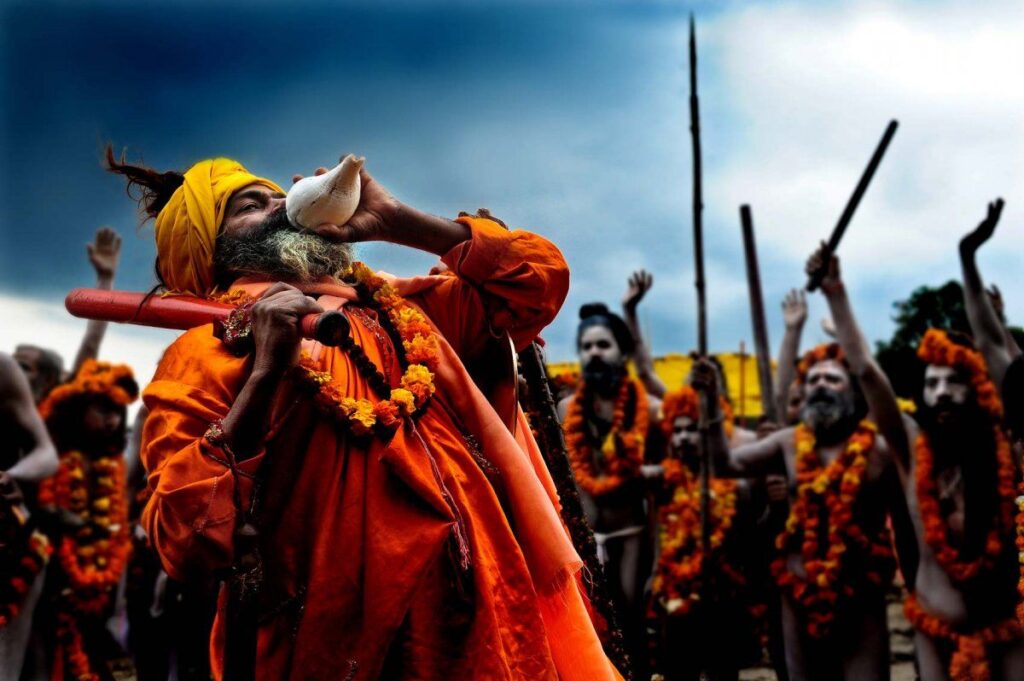
What is a Mahakumbh?
Imagine if Coachella, the Super Bowl, and the Pope’s Easter Mass all happened in the same place, at the same time, for six straight weeks. Now multiply that by a hundred. That’s Mahakumbh 2025.
The biggest human gathering on Earth. So extravagant it was that between January 13 and February 26, Prayagraj logged over 400 million visits.
But why do millions brave packed trains, shoulder-to-shoulder crowds, and cold nights on riverbanks just to dunk themselves in a freezing river? Because the scriptures say so!
According to Hindu mythology, gods and demons once churned the cosmic ocean for amrit (nectar of immortality). Mid-fight, four drops spilled out of the pot onto Earth, blessing four places in India: Haridwar, Ujjain, Nashik, and Prayagraj.
Ever since, every twelve years, when Jupiter and the Sun align astrologically, pilgrims return to bathe in these waters. One dip is said to wash away lifetimes of sin and help the soul liberate (the ultimate purpose of a being in Hinduism).
The six-week stretch of Mahakumbh 2025 included multiple astrologically charged bathing days, namely Makar Sankranti, Mauni Amavasya, Vasant Panchami, and more.
Smaller Kumbh Melas (Hindu pilgrimage involving ritual bathing for spiritual awakening, held every 12 years) rotate through the four cities every three years, but Mahakumbh in Prayagraj is the Super Bowl.
And this fortunate, deeply unprepared soul was about to become one of those 400 million.
Day 1 of Mahakumbh 2025: Launched, Lost, and Nearly Broken
So fortunate that when the train doors finally groaned open, I was launched straight out of the compartment by a tidal wave of limbs and luggage, and face-planted at the feet of a CRPF commando (India’s Central Reserve Police Force, essentially heavily armed security) whose nonchalance screamed he’d been watching pilgrims kiss precious Prayagraj soil since morning.
“Sector 9?” I croaked, once I’d regained verticality as I scanned the crowd for my parents, who, unlike their spiritual-frisbee daughter, had somehow managed to step onto solid ground like actual humans. The commando pointed toward the help booths near the exit.
After ten minutes of elbow-ducking through the crowd, I was ready to grill the booth guy who just needed to hear the word “sec” to start spilling every detail about routes, helplines, and setups.
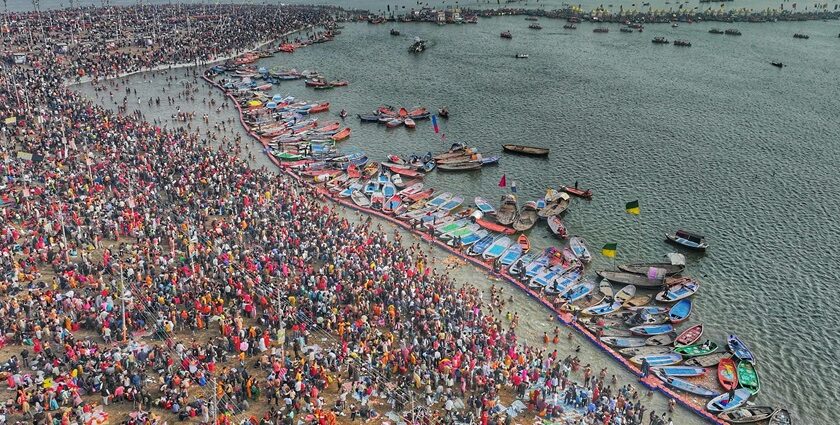
For perspective: every Mahakumbh, the government basically unleashes its inner Burning Man and builds an entire temporary city on the riverbanks, complete with roads, pontoon bridges, sectors, hospitals, and 150,000 portable toilets.
My destination was Sector 9, where my family’s guru (spiritual teacher), Shri Shri 1008 Mahamandleshwar Ramayani ji, had arranged accommodation at his khalsa (sect’s base camp with a collection of tents where followers of the same spiritual lineage stay together)
I’d imagined we’d arrive, kick back in tents, maybe enjoy something warm to eat. What I hadn’t imagined was, “It’s merely a six-kilometer walk. Sorry, no vehicles allowed.“
And So Unfolded the Mahakumbh 2025 Trail
At first, it wasn’t so bad.
I caught toddlers giggling on their dads’ shoulders, swapped stories with folks from villages I’d never heard of, and shouted “Har Har Mahadev!” (a devotional chant to Lord Shiva) with the crowd every time it kicked off.
Meanwhile, my guru-brothers (fellow disciples of my guru/ spiritual siblings) guided me over the phone, dropping landmarks: “Pass the medical tent on your left… when you hit the blue tarp, take a right…”
Then Google Maps threw hands!
Barricades popped out of nowhere. One minute, vendors were waving me one way; next, a cop told me to go the opposite.
By kilometer three, I was sweating out my sins along with my will to live. By four, I felt like I was carrying the weight of the world in my backpack. By six, which somehow became seven…eight…Nine, I swear I could hear every gym coach I ever blew off, laughing their heads off.
“I can’t find it.” I was close to breaking as I repeated my location to my guru-brother for what felt like the thousandth time.Before he could finish telling me the next directions, my phone died.
“Hello? Hello? Helloooo?” My hands trembled as I stared at the dead screen, shouting at it like it could help.
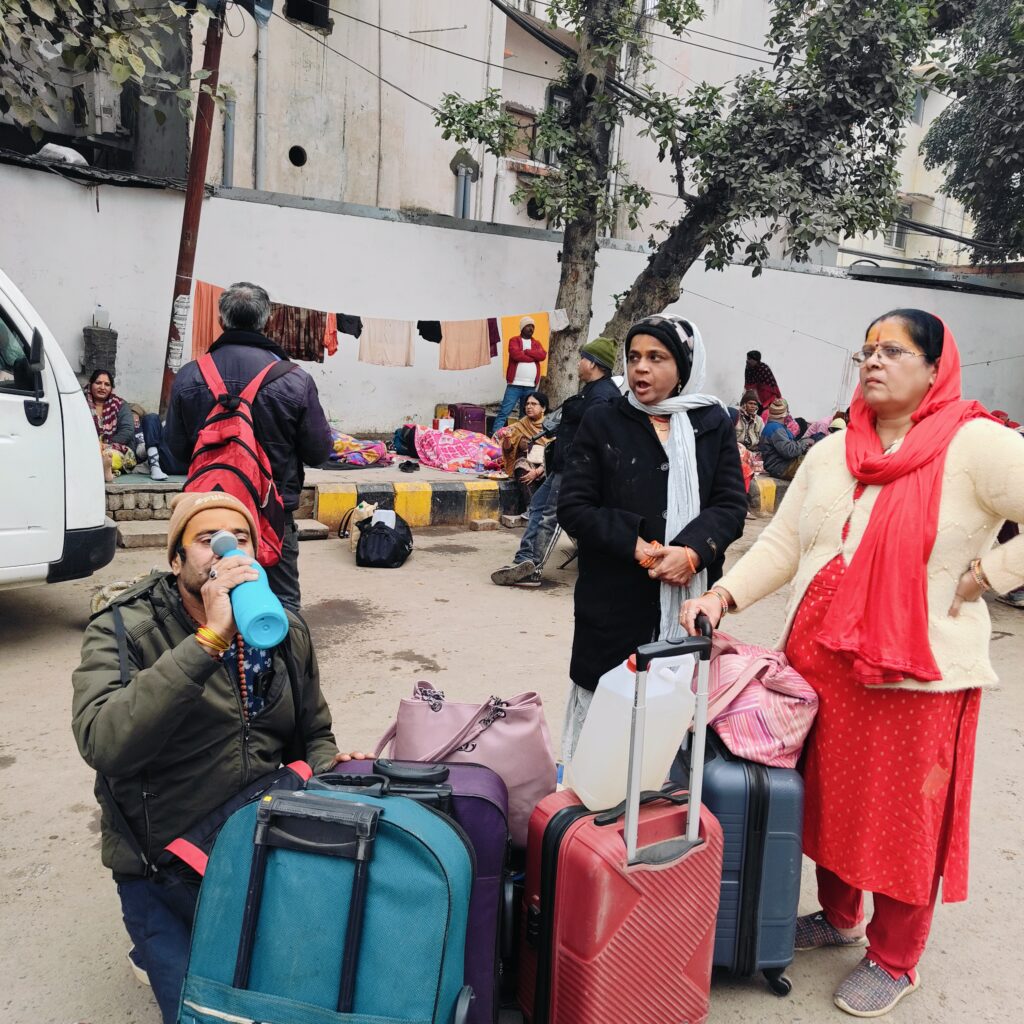
My weary parents and relatives sit beside our mountain of luggage.
I was stuck, miles from home, swallowed by a crowd of millions. Out of the corner of my eye, I saw Mom’s face, flushed and worried, and Papa’s heavy breath beside me.
I don’t think I’d ever felt so lost and helpless. I sank onto the sand, letting the tears roll down my cheek while Papa pestered the police, security, and whoever would listen for directions.
The Family That Saved My Ass (And My Faith in Humanity) – Mahakumbh 2025
“Sector 9, you said?” A voice thick with a Bihari accent finally replied. “We’re headed that way. Come with us.”
Hope surged through me as I looked up.
A family of eight stood close by: grandparents, a young couple, and four kids. The youngest, maybe three, sat perched on his father’s shoulders.
Granny handed me a water bottle while the kids helped with my bags. My legs trembled as I took my first steps. Instead of rushing ahead, they matched our tired pace.
We walked for what felt like hours. Unlike me, they were soaking it all in. The kids made up songs, blending Bollywood tunes with regional beats. They’d stop mid-verse, burst into giggles, and start again. The grandmother and my mom fell into easy conversation.
Eventually, I learned they had come for Santosh, the quiet seven-year-old who had been sick for months. Fevers that spiked without warning. Doctors had run tests, shrugged, and sent them home with more bills than answers.
“I brought my oldest here years ago,” the grandmother said. “Same illness. After the Sangam (the holy dip at the confluence), she never coughed a day.” She said it like she was telling me the sky is blue.
I didn’t know what to say. Part of me wanted to ask follow-up questions. What was the actual diagnosis? Did they get a second opinion? Or were they just clinging to the old belief that the sacred waters could heal what medicine couldn’t?
But as I watched the father hoist my mother’s bag onto his shoulder without being asked, watched them stop every few minutes to help other lost pilgrims even though they had no idea where they were going either, and split their food with us, the questions died in my throat.
They were heading to the ghats (stepped bathing areas along the riverbank) and planned to sleep on the riverbank. They didn’t have a sect camp awaiting their arrival or beds to keep them warm at night.
And yet they were bubbling with the enthusiasm of someone who knew life’s luxury awaited them. It made me feel ridiculous for nearly crying over a dead phone.
When we reached the pontoon bridge, the grandfather stopped. “Straight ahead. Look for saffron flags. Jai Siyaram (Hail Siyaram),” he pointed across the river.
Then they turned toward the ghats and disappeared into the crowd. I kept glancing back as we crossed the bridge. This family, with so little, had given us so much.
Every journey changes you a little — even the chaotic ones. Mahakumbh 2025 reminded me that travel isn’t just about where we go, but what we notice along the way. I’ve started collecting stories and reflections like this here, for anyone who wants to explore the deeper side of travel too.
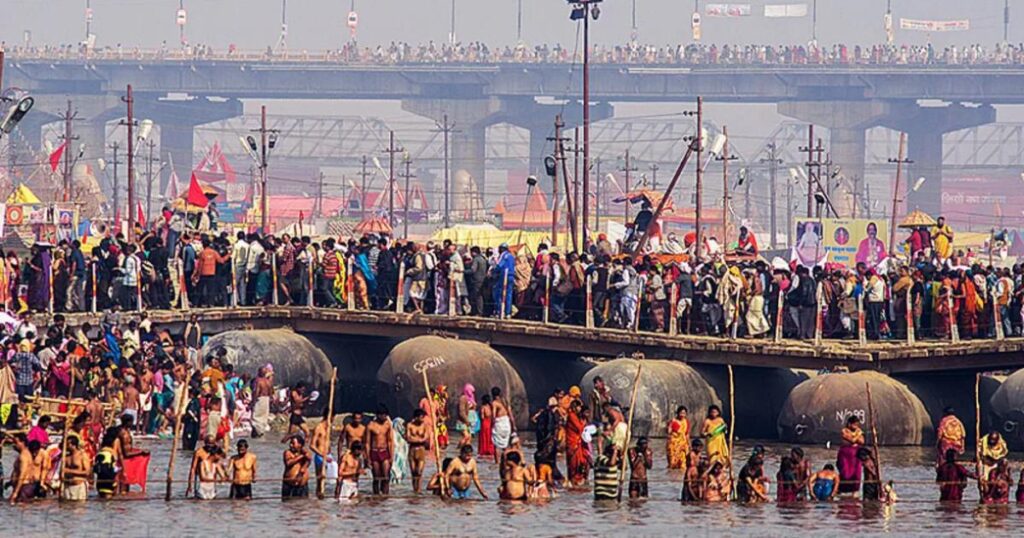
Across the River, Mahakumbh 2025 (Take Two)
My legs were shaking when I finally spotted the familiar faces of my guru-brothers on the other side of the bridge. They were scanning the crowd, faces tight with panic.
When they saw us, relief washed over them so fast I thought one might actually cry.
“Where WERE you?” Satyamji Bhai (one of my guru-brothers) was already sprinting toward us. “Your phone…we couldn’t reach you! Guruji nearly organized a full search operation, “
Before I could answer, he’d grabbed my bags while Ramvinayji Bhai (another guru-brother) pressed cold juice into my hands. Vaishno ji was apologizing, explaining how they’d been calling for hours, imagining every possible disaster.
Papa launched into the whole story right away, while I just stood there trying to hold it together. I didn’t cry. But every emotion close to it passed through me.
They walked us into what felt like a living SimCity with thousands of camps laid out in perfect grids, stitched together by paths of impossibly soft white sand. It was spotless despite the to and fro of millions of feet every hour.
Saffron flags were snapped overhead (sacred in Hinduism, symbolizing fire and purity). The air was moist with the misty fragrance of marigolds, which were everywhere, bright orange offerings said to please the gods.
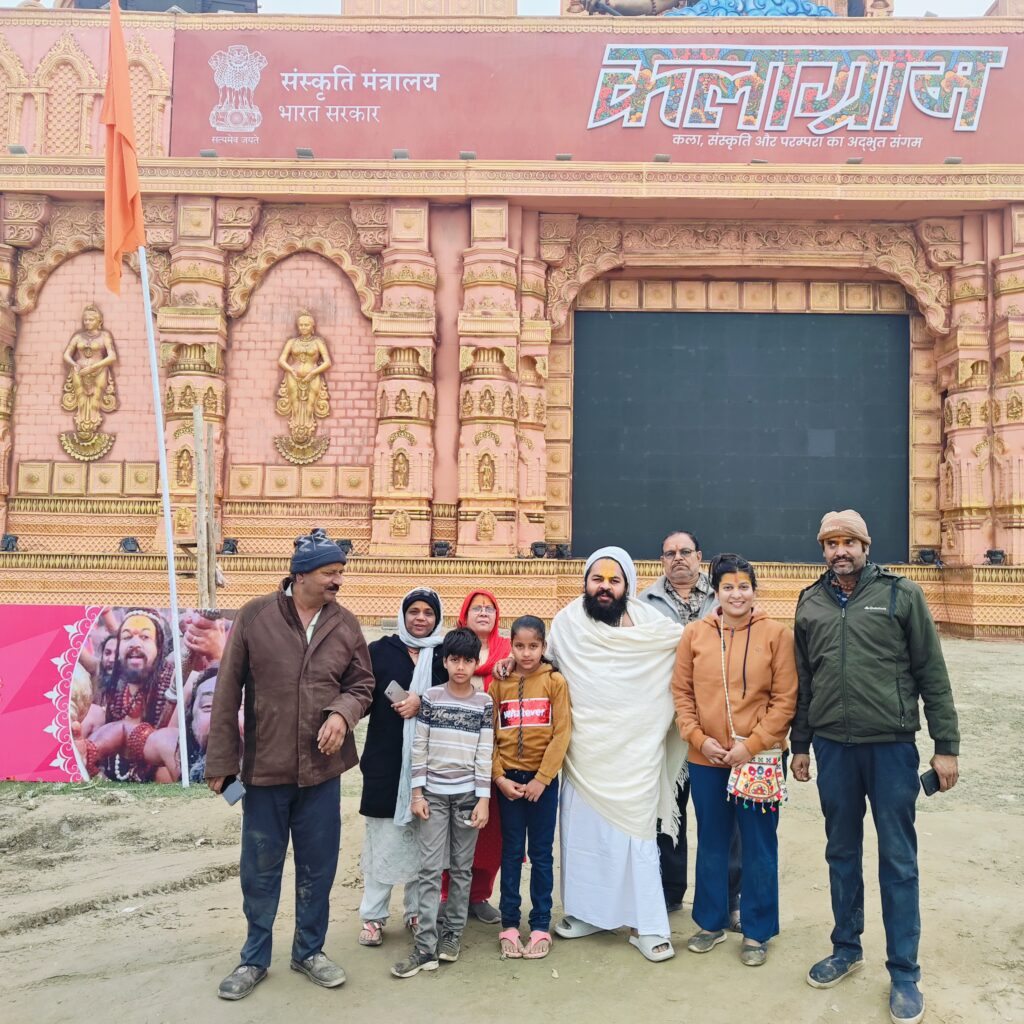
Then we reached the Panch-shree Terah Bhai Tyagi Khalsa, our sect’s camp, named after an old spiritual lineage. Inside, about fifty tents stood in formation, stretched over bamboo frames like a quiet army of devotion. A dream held together by faith and silence.
Someone appeared with chai. Someone else brought warm water for washing. A third person was already unzipping the tent and unrolling bedding.
My parents, somehow still functioning, went off to greet Guruji and everyone else they knew while I passed out like someone had hit me with a tranquilizer. Two hours later, my mother, refreshed, caffeinated, and running on some divine energy I clearly didn’t inherit, shook me awake.
“Get up. We didn’t walk nine kilometers to nap. Let’s go to the Sangam.“
I wanted to argue that, actually, napping was exactly what I’d walked nine kilometers for. But she was already waiting at the tent entrance, so I dragged myself up and followed.
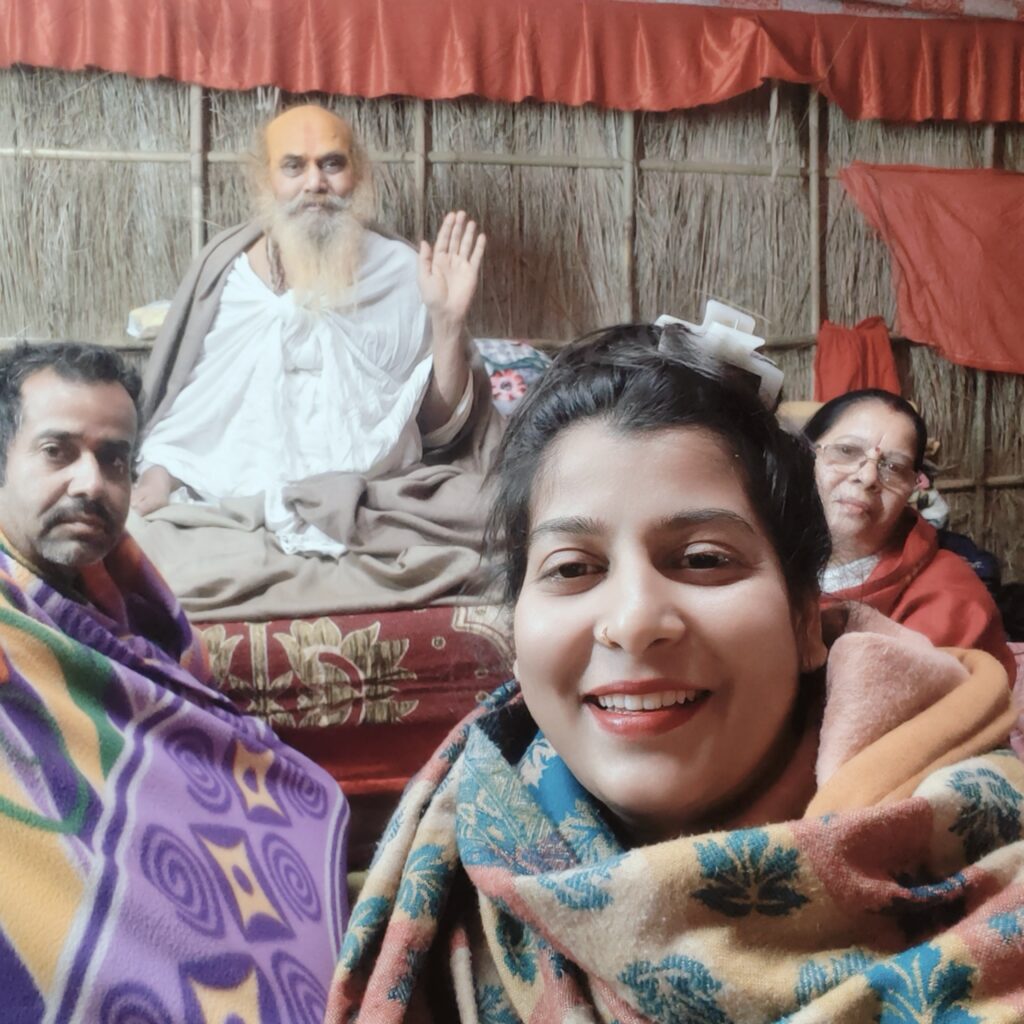
The First Dip at The Ganges River – Mahakumbh 2025
The walk to Triveni Sangam took about twenty minutes. The Mahakumbh 2025 crowd got thicker with every step. Chanting got louder. The air smelled like incense and river water and people…a ton of them! Then I saw the confluence…
You can actually see the different colors converging into one. The Ganges River is grayish-blue; the Yamuna River is darker and muddier. They create visible lines where they crash together, not mixing immediately but running parallel for a bit, like they’re negotiating terms before committing.
Millions of people were waist-deep in the water. Old women were gripping metal railings with one hand while scooping water with the other. Young guys were diving in headfirst, laughing. Entire families were linked together against the current, chanting in unison.
All of them were there with varied hopes.
The current was strong enough that they’d installed metal fencing along the ghats to avoid letting people wash out to the Bay of Bengal. I grabbed those bars the second I stepped in because the water hit me like a wall. It was glacier-fed and bone-cold. The kind of cold that hits before your brain can catch up.
It took maybe five minutes for the initial shock to wear off. Once it did, I felt weightless. Like I was floating above the clouds. I giggled and dipped again and again until I lost count.
Afterward, I scooped water in my palms like everyone else, and offered it to the setting sun, whispering mantras (sacred chants and prayers passed down through scriptures) I’d heard my whole life but never really understood what they meant until now. All around me, thousands moved in sync, drenched in devotion.
An old woman beside me was crying, but it wasn’t sorrow. A group of young guys splashed each other like kids, carefree and wide open. A family stood in a circle, hands clasped. Their voices rose and fell with the river’s rhythm. I don’t know how long I stayed in. Time had stopped mattering anyway.
When I finally climbed out, shivering, dazed, and weirdly emotional in a way I couldn’t name, my mom was waiting on the bank. She held out a towel and gave me a smile that said I told you so without saying a word.
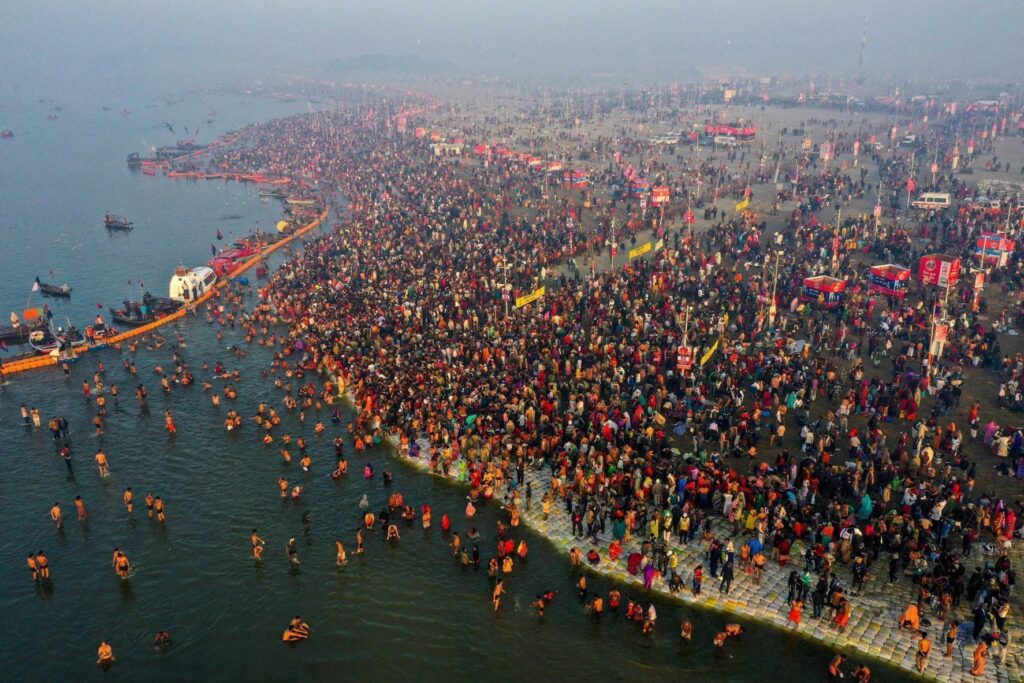
Day 2 of Mahakumbh 2025: Shahi Snan (The Royal Bath)
My mother smacked me awake at 4 AM.
“Brahma Muhurat, (the pre-dawn window, roughly 1.5 hours before sunrise, considered the most spiritually charged time for meditation, worship, and creative work in Hindu tradition)” she said, already dressed. “Get up. Makar Sankranti’s Shahi Snan waits for no one.“
I had no idea what half those words meant, but her tone suggested arguing would result in a second, harder smack.
Outside, the darkness of Mahakumbh 2025 was alive. A million people, maybe more, all moved toward the river like we’d been summoned by something invisible but undeniable. At the ghats, the crowd pressed so thick I couldn’t tell where I ended and other people began. But nobody moved into the water.
“Naga Sadhus first,” Mom whispered. I opened my mouth to prod the details, but shut right up as the deep, guttural chanting vibrated through my chest, my bones, and the sand beneath my feet.
I shuffled on my feet a bit and stood on my toes to peek.
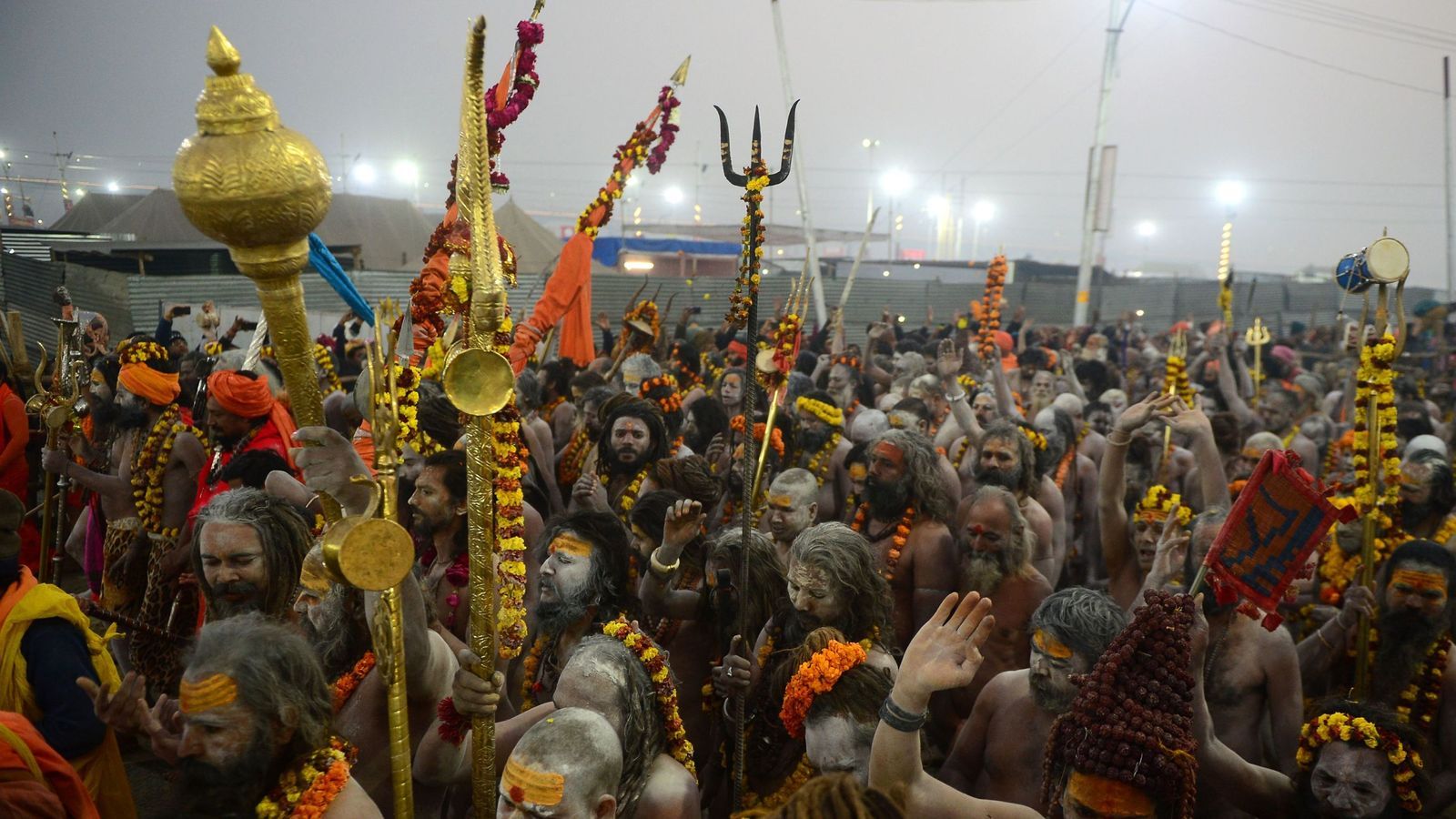
The Naga Sadhus (ascetic Hindu monks who renounce all worldly ties, live unclothed and smeared in ash as a symbol of detachment) emerged from the darkness like myths made flesh. Their bodies were smeared in white ash that glowed ghostly in the pre-dawn light. Some had dreadlocks coiled into towers on their heads. Others carried swords. All of them looked like they’d walked straight out of a story my grandmother would tell to scare me into behaving.
For a moment, it was solemn. Then one of them flicked water at another. The second responded with a bigger one, and within seconds, the mood shifted completely.
They were laughing, chasing each other through the freezing river. One dove under and popped up, gasping. Another wrapped his friend in a mock headlock. Someone launched into a cannonball, sending water flying
I stared at these aesthetically eccentric men who’d given up everything, who owned nothing, who slept on the ground and spent their lives in meditation, in awe as I thought about my four bags of luggage. My dead phone and how ridiculous my reaction had been! ‘
The Naga Sadhus stayed for forty minutes. Then, the ghats opened for the rest of us. I didn’t hesitate this time, dove headfirst, and I swear to god, I laughed on the way down.
The cold hit the same as yesterday, but I didn’t fight it. I dunked under again, let the current pull at me, felt irresponsibly careless in a way I haven’t since I was seven and consequences were someone else’s problem.
My mother waded in beside me. Her wobbly knees were somehow steady in the current. Her face had this peaceful expression I rarely see back home, where she’s constantly managing everyone’s chaos, cooking, cleaning, worrying, planning, and fixing.
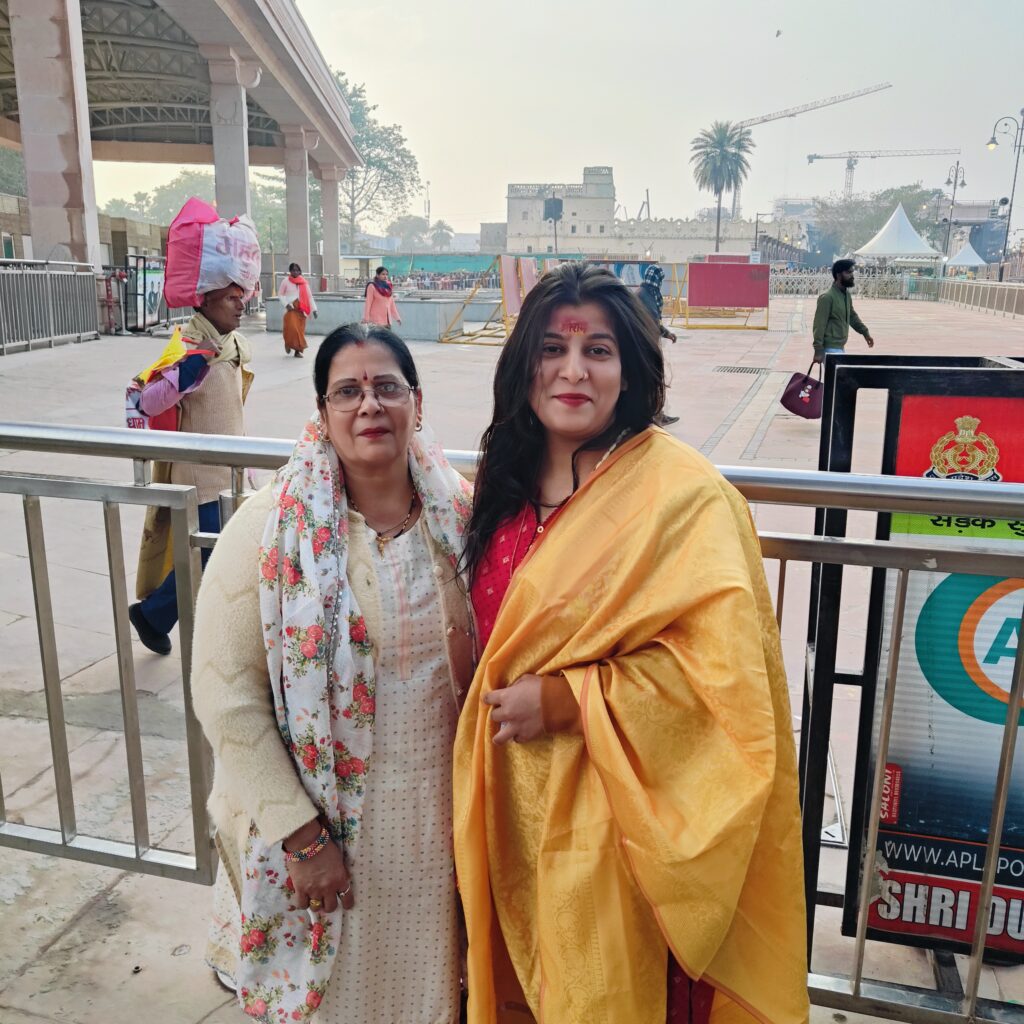
We didn’t talk. Just existed together in the river. Two women separated by decades and connected by everything.
What Actually Changed In Me During Mahakumbh 2025
That dawn, we ate from leaf plates using our hands. Simple lentils, flatbread, and spiced vegetables that somehow tasted better than any restaurant meal I’ve ever had.
Maybe because I was starving, or it could be the company. Probably both.
People stayed after dinner, talking and sharing stories. A woman recounted how she walked three days to get here and seemed genuinely happy about it. An elderly man reminisced about every Mahakumbh they’d attended since 1989, telling stories about each one like they were his greatest hits.
I thought about the Kumar family sleeping on the riverbank right then. Without the guru-brothers or tent or warm food. I had all of that because of connections I’d done nothing to earn. They had none of it and somehow seemed happier than I.
The next morning, my guru-brothers pulled mysterious strings, and I was dropped off at the railway station in a car with a VIP plate. CRPF personnel formed human barriers so we could board without getting trampled this time. The train left Prayagraj two hours late.
I watched the tent city disappear through the window. Mahakumbh didn’t make me a saint overnight. I still lie to dodge people. I still roll my eyes at my mom when she’s not looking. Still use my sibling’s expensive shampoo without asking.
My sin list is still long.
But something had fundamentally shifted. Last week, my phone died during a work meeting. The screen went black mid-presentation.
Normally I would’ve panicked. Scrambled for a charger. Convinced myself everything was falling apart, and it was definitely my fault, and everyone was judging me.
Instead, I just sat with it. Borrowed someone’s phone to send one message. It was fine. The meeting continued without me for ten minutes. The world didn’t end.
I notice when my mother’s breathing gets labored now. I don’t just assume she’s fine because she doesn’t complain. I inherited her stubbornness, but I’m learning to see past it. The Kumar family is still out there somewhere. Little Santosh might be healed. She might not be. But they showed up with nothing but hope.
And maybe that’s the point. Maybe faith isn’t about knowing it’ll work. It’s about showing up anyway.
If you enjoyed reading this article, check out some other ones here that might pique your interest:
Why do people really go to Mahakumbh?
It is a bit of faith and FOMO. Some come seeking liberation for the soul, others just want to witness a spectacle that makes Coachella look small. But somewhere between the noise, devotion sneaks in, even for the skeptics.
Is Mahakumbh as overwhelming as it sounds?
Completely and that’s what makes it unforgettable. Millions move like one living organism. It’s loud, chaotic, sacred, and strangely unifying. You lose your patience, your sense of direction, and maybe a sandal but it is life changing.
Do you actually feel “cleansed” after the holy dip?
Not instantly, and not in a miracle way. The river doesn’t erase your sins, but it washes off the rush, the control, the constant digital noise. You step out lighter, even if not holier.
How many people attended Mahakumbh 2025?
An estimated 400 million visitors participated in the 2025 Mahakumbh, making it one of the largest peaceful human gatherings in history.

